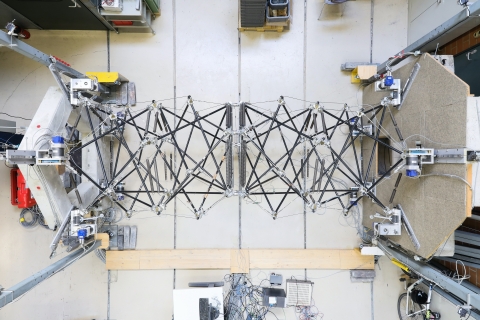You are here
Adaptive Aluminum Tensegrity Structure as a Bike Parking Canopy (In Progress)
Recent Project Updates
-
9/22/2020F&S staff met with the researchers to discuss the design constraints for installing the tensengrity structure for bike parking at Newmark Civil Engineering Lab (NCEL). Dr. Ann Scychterz and Dr. Nishant Garg at CEE met with Stacey DeLorenzo...
Project Family
-
iSEE Campus as a Living Lab (CALL) Projects
- Adaptive Aluminum Tensegrity Structure as a Bike Parking Canopy
- Addressing Community Health Disparities from Hazardous Waste
- Agrivoltaics: Crop Production and Solar Panels on the Same Land
- City Traffic as a Reservoir System
- Creating Adaptable Autonomous Systems for Energy-Efficient Buildings
- Environment-Enhancing Food, Energy, and Water Systems
- Faculty/Staff Crowdsourced Community Program
- Geothermal: Thermo-Hydraulic Properties of Glacial Tills
- I-PLACES Living Laboratory
- Integrating Groundwater Resources and Geothermal Energy for Water-Energy Security and Resilience
- Student Mobility on and around the Illinois campus
- Testing Geopolymer Performance in a Geothermal Exchange System
- Thermochemical Batteries: Turning Waste Heat into an Energy Source
- Towards Zero Waste: Automated Waste Classification via Computer Vision
- Wind Turbine/Pavilion Integration for Electricity Generation
Associated Collections
Description
Funded in Summer 2020, this project seeks to expand the sustainability and longevity of structural engineering by installing an aluminum bicycle canopy on the Engineering Quad.
The field of adaptive structures is emerging as a sustainable alternative to current inflexible designs. Tensegrity structures, skeletal constructions of bars and cables held together when the cables are in tension, are highly adaptive and have a high strength-to-weight ratio. A primary challenge with large-scale tensegrity structures that has hindered their implementation in structural engineering is building robust joints that are both strong and flexible. Aluminum is a lightweight material that not only complements the lightweight structural design, but also provides corrosion resistance and infinite recyclability.
An on-campus aluminum tensegrity structure will provide the research team with critical insight to inform larger-scale applications of the design (e.g., performance of aluminum alloys, response to environmental stimuli, maintenance costs, etc.). Potential applications include emergency response infrastructure and extra-terrestrial construction.
Background
Purpose of the Work: Campus Connection
With iSEE seed funding and support from Facilities & Services (F&S), researchers will design and analyze an aluminum bicycle parking canopy on the south face of the Newmark Civil Engineering Building, 205 N. Mathews Ave., Urbana.
In addition to the low-waste and low-energy qualities inherent to the dynamic tensegrity design, the bicycle canopy will support sustainable, low-emission transportation. The accessibility of weather-resistant and safe bicycle storage on the North Quad will provide an incentive for students, staff, and faculty members who frequent that area to opt for bike travel year-round, even and especially in inclement weather.
Project Team
-
Team Members:
- Ann Sychterz, Assistant Professor, Civil and Environmental Engineering
- Nishant Garg, Assistant Professor, Civil and Environmental Engineering
Themes
-
Primary Theme:
Other Themes:
Project Location(s)
This map is interactive! Click (or touch) and drag to pan; scroll (or pinch) to zoom.

